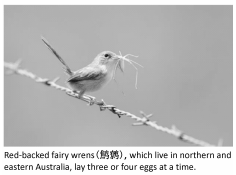
分析 本文是一篇说明文,论述了自制蒸馏器的组成成分及工作程序.
解答 DBCD
32.D 细节理解题.根据第一段第三句前半句 Unfortunately,you must carry the necessary equipment with you …可知,太阳能蒸馏器设备必须被携带,因此其是可以携带的,其余选项文章均未提及,故正确答案为D.
33.B 推理判断题.根据第二段划线词组前面的句子可知,其为蒸馏器的制作过程以及放置地点.后面的 increase productivity 为增加产量,因此可以推断该词组为蒸馏器,故正确答案为B.
34.C 细节理解题.根据文章第三段第一句后半句 …weighting the sheet's center down with a rock 可知,用石头让塑料布中心下降是制造太阳能蒸馏器的最后一步,后文没有再介绍制造过程,故正确答案为C.
35.D 细节理解题.根据文章随后一段第二句 Ground water evaporates and collects on the sheet until small drops of water form,run down the material and fall off into the cup 可知,地面上的水蒸发并且在塑料布上,形成小水滴后落在杯子里,因此可以得知水滴来自塑料布下方,故正确答案为D.
点评 阅读理解题测试考生在阅读基础上的逻辑推理能力,要求考生根据文章所述事件的逻辑关系,对未说明的趋势或结局作出合理的推断;或根据作者所阐述的观点理论,对文章未涉及的现象、事例给以解释.考生首先要仔细阅读短文,完整了解信息,准确把握作者观点.


 阳光课堂课时优化作业系列答案
阳光课堂课时优化作业系列答案科目:高中英语 来源: 题型:选择题
| A. | Sounds like fun | B. | It depends | C. | Just a minute | D. | You are welcome |
查看答案和解析>>
科目:高中英语 来源: 题型:阅读理解
查看答案和解析>>
科目:高中英语 来源: 题型:完形填空
| 41.A.road | B.car | C.store | D.entrance |
| 42.A.coming up with | B.putting up with | C.keeping up with | D.keeping in touch with |
| 43.A.hospital | B.department | C.studio | D.waiting room |
| 44.A.herself | B.Mommie | C.doctors | D.nurses |
| 45.A.Whenever | B.Whatever | C.However | D.Wherever |
| 46.A.spent | B.taken | C.cost | D.wasted |
| 47.A.said | B.shared | C.spared | D.told |
| 48.A.cured | B.experienced | C.treated | D.experimented |
| 49.A.leg | B.face | C.head | D.hand |
| 50.A.realized | B.noticed | C.knew | D.wondered |
| 51.A.checks | B.belongings | C.bills | D.change |
| 52.A.unlike | B.because of | C.as to | D.in front of |
| 53.A.constantly | B.seldom | C.never | D.occasionally |
| 54.A.excited | B.curious | C.surprised | D.angry |
| 55.A.similar | B.familiar | C.different | D.unfortunate |
| 56.A.talk | B.think | C.complain | D.ask |
| 57.A.high | B.normal | C.full | D.low |
| 58.A.look | B.take | C.link | D.think |
| 59.A.reminded | B.informed | C.requested | D.admitted |
| 60.A.girl | B.example | C.exception | D.patient |
查看答案和解析>>
科目:高中英语 来源: 题型:阅读理解
查看答案和解析>>
科目:高中英语 来源: 题型:书面表达
查看答案和解析>>
科目:高中英语 来源: 题型:阅读理解
查看答案和解析>>
科目:高中英语 来源: 题型:阅读理解
 Before birth,babies can tell the difference between loud sounds and voices.They can even distinguish their mother's voice from that of a female stranger.But when it comes to embryonic learning(胎教),birds could rule the roost.As recently reported in The Auk:Ornithological Adrances,some mother birds may teach their young to sing even before they hatch(孵化).New-born chicks can then imitate their mom's call within a few days of enering the world.
Before birth,babies can tell the difference between loud sounds and voices.They can even distinguish their mother's voice from that of a female stranger.But when it comes to embryonic learning(胎教),birds could rule the roost.As recently reported in The Auk:Ornithological Adrances,some mother birds may teach their young to sing even before they hatch(孵化).New-born chicks can then imitate their mom's call within a few days of enering the world.查看答案和解析>>
科目:高中英语 来源:2017届广东省揭阳市高三第一次模拟考试英语试卷(解析版) 题型:阅读理解
In agrarian(农业的), pre-industrial Europe, “you’d want to wake up early, start working with the sunrise, have a break to have the largest meal, and then you’d go back to work,” says Ken Albala, a professor of history at the University of the Pacific. “Later, at 5 or 6, you’d have a smaller supper.”
This comfortable cycle, in which the rhythms of the day helped shape the rhythms of the meals, gave rise to the custom of the large midday meal, eaten with the extended family. “Meals are the foundation of the family,” says Carole Couniban, a professor at Millersville University in Pennsylvania, “so there was a very important interconnection between eating together and strengthening family ties.”
Since industrialization, maintaining such a slow cultural metabolism has been much harder, with the long midday meal shrinking to whatever could be stuffed into a lunch bucket or bought at a food stand. Certainly, there were benefits. Modern techniques for producing and shipping food led to greater variety and quantity, including a tremendous increase in the amount of animal protein and dairy products available, making us more energetic than our ancestors.
Yet plenty has been lost too, even in cultures that still live to eat. Take Italy. It’s no secret that the Mediterranean diet is healthy, but it was also a joy to prepare and eat. Italians, says Counihan, traditionally began the day with a small meal. The big meal came at around 1 p.m. In between the midday meal and a late, smaller dinner came a small snack. Today, when time zones have less and less meaning, there is little tolerance for offices’ closing for lunch, and worsening traffic in cities means workers can’t make it home and back fast enough anyway. So the formerly small supper after sundown becomes the big meal of the day, the only one at which the family has a chance to get together. “The evening meal carries the full burden that used to be spread over two meals,” says Counihan.
1.What does Professor Carole Counihan say about pre-industrial European families eating meals together?
A. It was helpful to maintaining a nation’s tradition.
B. It brought family members closer to each other.
C. It was characteristic of the agrarian culture.
D. It enabled families to save a lot of money.
2.What does “cultural metabolism”(Line 1, Para. 3) refer to?
A. Evolutionary adaptation. B. Changes in lifestyle.
C. Social progress. D. Pace of life.
3.What does the author think of the food people eat today?
A. Its quality is usually guaranteed.
B. It is varied, abundant and nutritious.
C. It is more costly than what our ancestors ate.
D. Its production depends too much on technology.
4.What does the author say about Italians of the old days?
A. They enjoyed cooking as well as eating.
B. They ate a big dinner late in the evening.
C. They ate three meals regularly every day.
D. They were expert at cooking meals.
查看答案和解析>>
湖北省互联网违法和不良信息举报平台 | 网上有害信息举报专区 | 电信诈骗举报专区 | 涉历史虚无主义有害信息举报专区 | 涉企侵权举报专区
违法和不良信息举报电话:027-86699610 举报邮箱:58377363@163.com